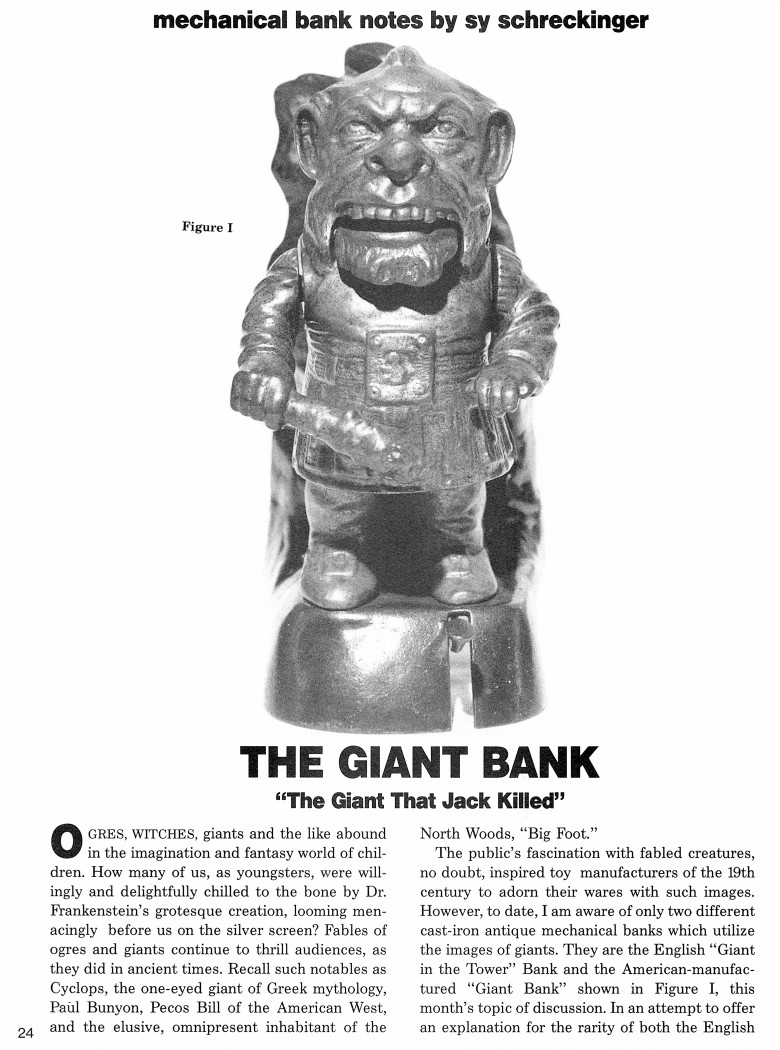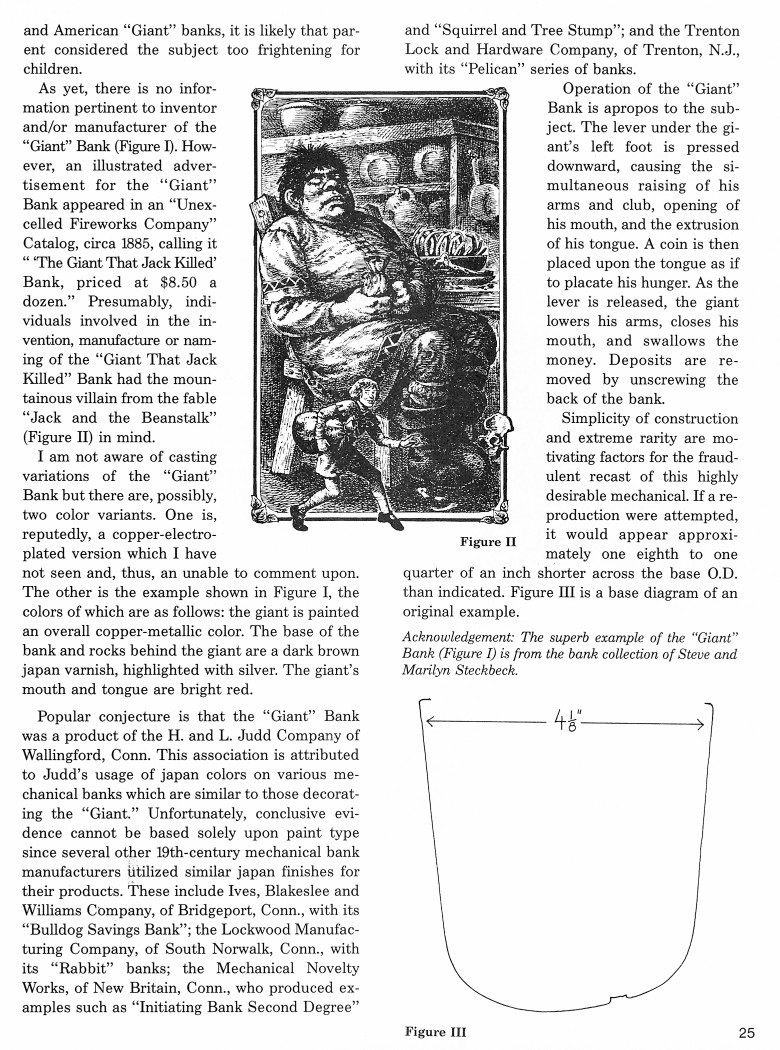|
The Giant Bank
“The Giant That Jack Killed”
by Sy Schreckinger – ANTIQUE TOY WORLD Magazine – November, 1995
Ogres, witches, giants and the like abound in
the imagination and fantasy world of children. How many of us, as
youngsters, were willingly and delightfully chilled to the bone by Dr.
Frankenstein's grotesque creation, looming menacingly before us on the
silver screen? Fables of ogres and giants continue to thrill audiences, as
they did in ancient times. Recall such notables as Cyclops, the one-eyed
giant of Greek mythology, Paul Bunyon, Pecos Bill of the American West,
and the elusive, omnipresent inhabitant of the North Woods, "Big Foot."
The public's fascination with fabled creatures, no doubt, inspired
toy manufacturers of the 19th century to adorn their wares with such
images. However, to date, I am aware of only two different cast-iron
antique mechanical banks which utilize the images of giants. They are the
English "Giant in the Tower" Bank and the American-manufactured "Giant
Bank" shown in Figure I, this month's topic of discussion. In an attempt
to offer an explanation for the rarity of both the English and American
"Giant" banks, it is likely that parent considered the subject too
frightening for children.
As yet, there is no information pertinent to inventor and/or
manufacturer of the "Giant" Bank (Figure I). However, an illustrated
advertisement for the "Giant" Bank appeared in an "Unexcelled Fireworks
Company" Catalog, circa 1885, calling it " 'The Giant That Jack Killed'
Bank, priced at $8.50 a dozen." Presumably, individuals involved in the
invention, manufacture or naming of the "Giant That Jack Killed" Bank had
the mountainous villain from the fable "Jack and the Beanstalk" (Figure
II) in mind.
I am not aware of casting variations of the "Giant" Bank but there
are, possibly, two color variants. One is, reputedly, a
copper-electroplated version which I have not seen and, thus, an unable to
comment upon. The other is the example shown in Figure I, the colors of
which are as follows: the giant is painted an overall copper-metallic
color. The base of the bank and rocks behind the giant are a dark brown
japan varnish, highlighted with silver. The giant's mouth and tongue are
bright red.
Popular conjecture is that the "Giant" Bank was a product of the H.
and L. Judd Company of Wallingford, Conn. This association is attributed
to Judd's usage of japan colors on various mechanical banks which are
similar to those decorating the "Giant." Unfortunately, conclusive
evidence cannot be based solely upon paint type since several other
19th-century mechanical bank manufacturers utilized similar japan finishes
for their products. These include Ives, Blakeslee and Williams Company, of
Bridgeport, Conn., with its "Bulldog Savings Bank"; the Lockwood
Manufacturing Company, of South Norwalk, Conn., with its "Rabbit" banks;
the Mechanical Novelty Works, of New Britain, Conn., who produced examples
such as "Initiating Bank Second Degree" and "Squirrel and Tree Stump"; and
the Trenton Lock and Hardware Company, of Trenton, N.J., with its
"Pelican" series of banks.
Operation of the "Giant" Bank is apropos to the subject. The lever
under the giant's left foot is pressed downward, causing the simultaneous
raising of his arms and club, opening of his mouth, and the extrusion of
his tongue. A coin is then placed upon the tongue as if to placate his
hunger. As the lever is released, the giant lowers his arms, closes his
mouth, and swallows the money. Deposits are removed by unscrewing the back
of the bank.
Simplicity of construction and extreme rarity are motivating factors
for the fraudulent recast of this highly desirable mechanical. If a
reproduction were attempted, it would appear approximately one eighth to
one quarter of an inch shorter across the base O.D. than indicated. Figure
III is a base diagram of an original example.
Acknowledgement: The superb example of the "Giant" Bank (Figure I) is
from the bank collection of Steve and Marilyn Steckbeck.
|


